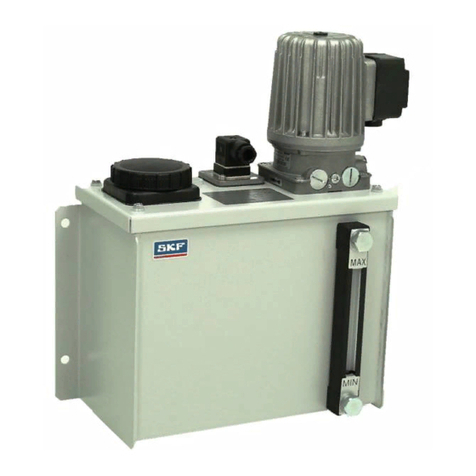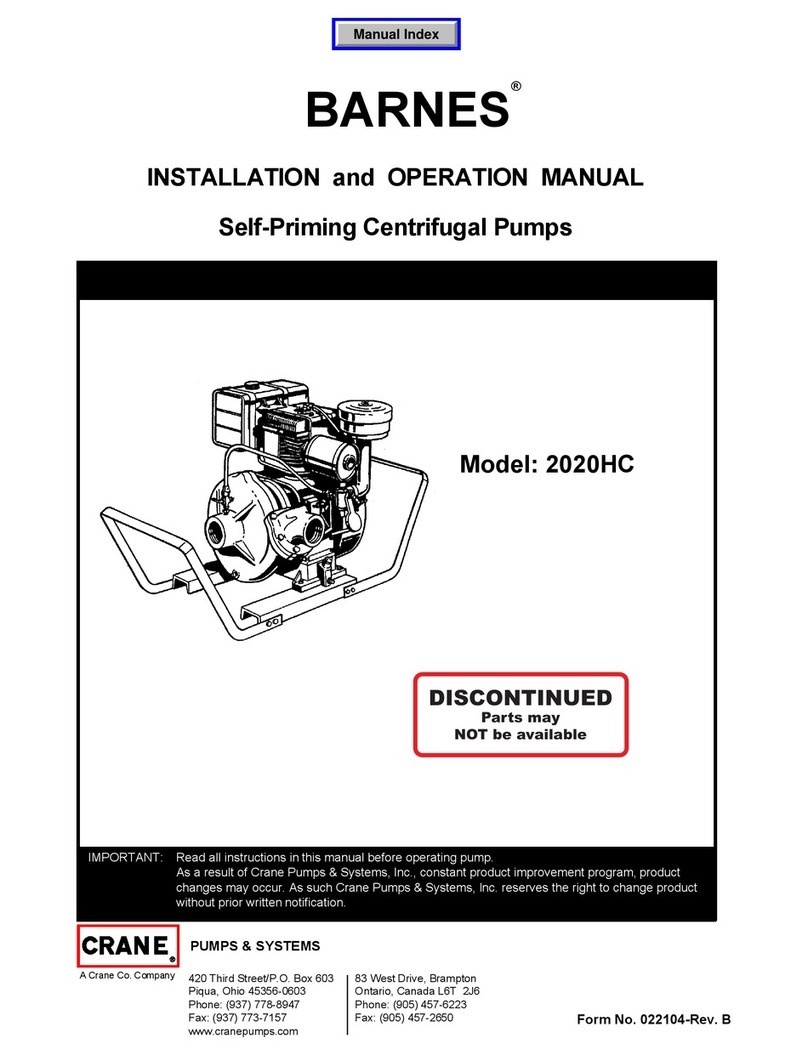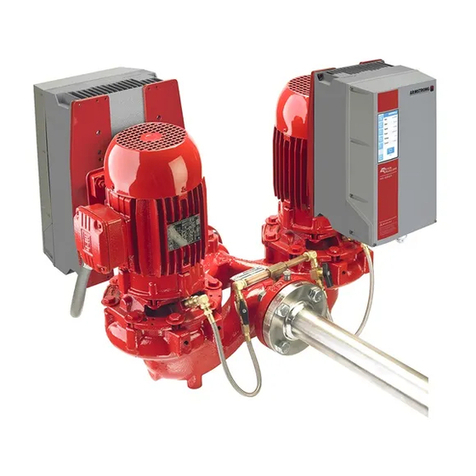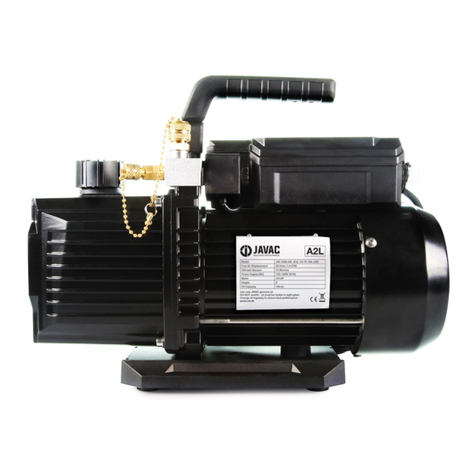Flotronic F Slim series User manual

The simplest ideas are often the best
Flotronic ‘One - Nut’ pumps
In tallation Operation and
Maintenance Manual
Flotronic One-Nut Air Driven Double Diaphragm Pumps
and Ancillary Equipment
PLEASE KEEP FOR
FUTURE REFERENCE
ATEX APPROVED PUMPS
ATEX Gas
Group IIC
comp iant
pumps now
avai ab e
W: www.flotronicpumps.co.uk
E: sales@flotronicpumps.co.uk
S: www.flotronicspares.co.uk

The Pumps
F Series award-winning metal pumps
Machined from solid material, these compact and self-draining
pumps are available in 316 stainless steel, aluminium and also
exotic metals, including Hastelloy®. These pumps can be used in
a wide range of industries including chemical, cosmetic, paints,
pharmaceutical, adhesive and hygienic applications. Recently voted
winner of the prestigious Food Hygiene Award for Food Processing
and Manufacture.
Only ‘one nut’ to access diaphragms with pump ‘in-line’
Only four nuts and bolts to access balls and seats (where fitted)
Only four bolts to maintain air valve with pump ‘in-line’
†Max operating temp 121oC (250oF) with high temp diaphragm
(specify H as 6th digit in pump code)
F Series Polypropylene, PVC, PVDF and aluminium pumps
Solid blocks of plastic supported by metal air domes, top and
bottom plates and through studs offer safety without compromising
fast maintenance. Normally used for solvents/chemicals and dyes
and often as a less expensive option for stainless steel.
Only ‘one nut’ to access diaphragms with pump ‘in-line’
Only four nuts to access balls and seats
Only four bolts to maintain air valve with pump ‘in-line’
†Max operating temp 80oC for all plastic pumps.
121oC for aluminium with high temp diaphragms.
F Series stainless steel and exotic metal pumps
Fabricated 316 or 304 stainless steel or Hastelloy®on all wetted
metal parts offers unrivalled versatility. These pumps are used
extensively throughout industry from acids to adhesives, cosmetics
to ceramics, petrochemicals to paper stock and solvents to solids
in suspension. Even dairy and food stuffs.
Only ‘one nut’ to access diaphragms with pump ‘in-line’
Only two nuts and bolts to access balls and seats
Only four bolts to maintain air valve with pump ‘in-line’
†Max operating temp 121oC (250oF) with high temp diaphragm
(specify H as 6th digit in pump code)
F Series Chemflo virgin and anti-static PTFE pumps
A solid block of virgin or anti-static PTFE housed completely inside
an outer metal ‘Pressure Vessel’ of carbon or stainless steel gives
inherent safety whilst retaining ‘one nut’ maintenance. Used for
extremely hazardous acids and chemicals where only PTFE can
be used and often in pilot plants or as emergency pumps where
chemicals are unknown.
The ultimate solid PTFE Double Diaphragm Pump
†Max operating temp 121oC (250oF) with high temp diaphragm
(specify H as 6th digit in pump code)
SLIM
500
710
K

Section No. Description Page
Section 1 General Information 2
Section 2 Training 2
Section 3 Limitation of Use 3
Section 4 Essential Safety Requirements (ESR) 4
Section 5 ATEX Safety Manual 6
Section 6 Installation 8
Section 7 Hydrostatic Testing 10
Section 8 Operation of Pumps & Torque Figures 11
Section 9 Noise Levels 13
Section 10 Servicing & Diaphragm Fitting Instructions 14
Section 11 F Series 500 Style Plastic & Aluminium Pumps 18
Section 12 F Series 710 Style Stainless Steel Pumps 24
Section 13 F Series Good Food Style Pump 30
Section 14 F Series Slim Style Metallic Pumps 35
Section 15 F Series ‘K’ Style Chemflo All PTFE 40
Section 16 Air Valves 45
Section 17 Pulsation Dampers 47
Section 18 Rupture Protection, Barrier & Alarm Systems 52
Section 19 Count & Stop Pumps All Series 60
Section 20 Trouble Shooting 62
Section 21 Further Assistance 64 & 67
Contents
1

Section 1 - General Information
“Declaration of Conformity”
“As defined by the Machinery Directive 2006/42/EC, and complies with the essential Health & Safety
requirements, Annex 1, and the technical construction file requirements of the Directive.
This pump complies with the Pressure Equipment Directive (PED) 97/23/EC Category 1 Module A.”
A declaration of conformity accompanies all pumps, and all pumps carry the C.E. Mark as required by U.K
and European Law effective January 1st 1995.
Section 2 - Training
It is recommended, and a part of the CE regulations that users personnel who will be involved in the
installation, operation and/or maintenance of FPL products should have the opportunity of an initial
training period,which can be carried out either at FPL works or customers premises by arrangement.
This training is offered by Flotronic in 3 different forms.
a Informal training in your maintenance workshop by our Technical Sales Representative on a Free of
Charge basis.
b Formal training in your training rooms by our skilled training personnel using visual aids, ‘hands on’
equipment etc, at an agreed cost to be confirmed.
c Formal training at FPL Premises by our skilled training personnel using visual aids, ‘hands on’
equipment, etc, at an agreed cost to be confirmed.
It is your responsibility to request your preferred training method now. Flotronic will not consider
responsibility for ongoing breakdowns etc, if training has not been given.
FPL offer a friendly after sales policy but, reserve the right to charge for “call out” visits that are
found to be caused through operator/fitter error.
2
General Information/Training

Section 3 - Limitations of Use
FPL products are designed to provide performance generally, as shown in accompanying literature
associated with the individual models or series. See Section 11 to 15. All performance figures are given
in good faith and are based on tests at FPL works using water at ambient temperature.
Operating temperatures are governed by the materials of construction of software parts, i.e. diaphragms,
balls, seals etc, and it is the installers responsibility to ensure that these maximum temperatures are
not exceeded under any circumstances.
Performance figures provided by FPL against individual enquiries are estimates only, and are subject
to variations depending upon air pressure and volumes of air provided by client, and to head losses due
to pipework, valves, etc which may be unknown to Flotronic estimators.
All performance figures, temperatures, flow rates, dimensions & other details are subject to change
without notice.
Due to the wide variety of products handled by FPL pumps, it is impossible for FPL to give a firm
recommendation regarding materials of construction for pump components. It is the users or specifiers
responsibility to determine the effect of corrosion & abrasion, and the general suitability of any pump
supplied for any individual application. FPL will, however, give advice in such material selection as it
may be able to do so in good faith.
3
Limitations of Use

Section 4 - Essential Safety Requirements (ESR)
ATEX DIRECTIVE 2014/34/EU (EXPLOSION AZARD SAFETY)
All FPL products that are certified to comply with the Directive also carry a specific ATEX Safety Manual
(Section 5) which must be referred to in conjunction with this manual. It is the responsibility of the user to
ensure that the equipment is correctly rated for the environment in which it is to be used.
When handling FPL products,please note weights given on FPL literature. Lifting equipment may be
required in certain cases.
Note that all pumps despatched from our works are tested with water and during storage,
packing and installation, some water will have remained in the pump body. This water may cause
spillage during handling. Water could react with the products you wish to pump,and it is your
responsibility to check this before putting the pump into operation. Water may also freeze if the pump
is exposed to sub zero temperatures. Do not operate the pump under these conditions as ice inside
the pump may cause damage to working parts of the pump.
At all times the installer must wear suitable clothing, footwear, goggles, etc for personal protection.
This particularly applies when the pump is being operated or maintained.
As with all double diaphragm pumps, it must be expected that diaphragm failure will occur without
warning and under these conditions, leakage of product can occur from the exhaust silencers unless a
guardian or barrier system is fitted (see Section 18).
If the product being processed is hazardous,then provision must be made by the user to deal with
this problem. This can be achieved by either specifying a guardian or barrier system as part of the
original pump specification or, as a retrofit from FPL works, or the silencers must be removed and
replaced by pipework which can carry the leakage to a safe place. Please note that wherever the
product is piped, pulses of mixed air and product will occur at the end of the pipework when diaphragm
failure has occurred. Provision must be made to accept the volumes of air/product mixture and the
pressures realised at that point.
If the product being pumped is corrosive or hazardous in any form, then provision must be made in the
piping construction to accept the mixed air/product that will be discharged under diaphragm failure
conditions.
Note the product may remain inside the pump after use and may be under pressure.
4
Essential Safety
Requirements (ESR)

Health Hazard Warning
Please note that PTFE is used in FPL pumps when specified in diaphragms, seals, seats and other
components.
At temperatures up to 250°C polytetrafluoroethylene (PTFE) is completely inert so that on the rare
occasions when the diaphragm fails or cracks,there is no direct danger from these components, other
than if particles are allowed to be carried into the process liquids.
At higher temperatures however, small quantities of toxic fumes can be produced and the direct inhalation
of these can cause an influenza type of illness, which may not appear for some hours, but which subsides
without after effects in 24 to 48 hours. Such fumes can arise from PTFE particles picked up on the end
of a cigarette, or in the presence of any open flame or similar ie electric fire, therefore smoking should
be prohibited when pumps are being serviced or PTFE components are being handled.
The disposal of PTFE components such as diaphragms etc. must be carefully controlled and under no
circumstances should be burned. When these components are scrapped, disposal must be made safely
and if disposed of through normal rubbish collection, the local authorities should be advised that such
disposal is being carried out.
5
ealth azard Warning

Section 5 - ATEX Safety Manual
For Air Driven Diaphragm Pumps
and Ancillary Equipment
User Instructions to ensure compliance with
European Directive 2014/34/EU
1.0 GENERAL 6-1
1.1 ATEX Directive 2014/34/EU 6-1
1.2 Disclaimer 6-1
1.3 Personnel qualifications and training 6-1
2.0 SAFETY 6-2
2.1 Summary of safety marking 6-2
2.2 Products used in potentially explosive atmospheres 6-2
2.3 Scope of compliance 6-2
2.4 Marking 6-3
2.5 Avoiding excessive surface temperatures 6-3
2.6 Preventing the build up of explosive mixtures 6-4
2.7 Preventing sparks 6-4
2.8 Preventing leakage 6-5
2.9 Maintenance to the diaphragm pump to avoid the hazard 6-5
2.10 Additional Safety Instructions 6-6
6
ATEX Safety Manual

1.0 GENERAL
These instructions must always be kept close to the product’s operating location or directly with the
product.
These instructions are intended to facilitate familiarisation with the product and its permitted use to
help satisfy ATEX safety requirements. The instructions may not have taken into account local
regulations; ensure such regulations are observed by all, including those installing the product.
Always co-ordinate repair activity with operations personnel, and follow all plant safety requirements and
applicable safety and health/law regulations.
These instructions should be read prior to installing, operating, using and maintaining the equipment
in any region worldwide and in conjunction with the main user instructions provided. The equipment must
not be put into service until all the conditions relating to safety instructions have been met.
1.1 DIRECTIVE 2014/34/EU
It is a legal requirement that machinery and equipment put into service within certain regions of the
world shall conform with the applicable CE Marking Directives for Equipment for Potentially Explosive
Atmospheres (ATEX).
Where applicable the Directive covers important safety aspects relating to the equipment, its use
and the satisfactory provision of technical documents. Where applicable this document incorporates
information relevant to these Directives. To establish if the product itself is CE marked for a Potentially
Explosive Atmosphere check the nameplate and the Certification provided.
1.2 Disclaimer
Information in these User Instructions is believed to be reliable. In spite of all the efforts of Flotronic
Pumps Ltd to provide sound and all necessary information, the content of this Manual may appear
insufficient and is not guaranteed by Flotronic Pumps Ltd as to its completeness or accuracy.
1.3 Personnel qualifications and training
All personnel involved in the operation, installation, inspection and maintenance of the unit must be
qualified to carry out the work involved. If the personnel in question do not already possess the necessary
knowledge and skill, appropriate training and instruction must be provided. If required the operator may
commission the manufacturer/supplier to provide applicable training.
6-1
ATEX Safety Manual

2.0 SAFETY
2.1 Summary of safety marking
These instructions contain the following specific ATEX safety marking where non-observance of the
instruction will cause a hazard.
This symbol indicates explosive atmosphere marking according to ATEX. It is used in safety
instructions where non-compliance in the hazardous area would cause the risk of an explosion.
2.2 Products used in potentially explosive atmospheres
Measures are required to
Avoid excess temperature
Prevent build up of explosive mixtures
Prevent the generation of sparks
Prevent leakages
Maintain the pump to avoid hazard
The following instructions for pumps and pump units when installed in potentially explosive atmospheres
must be followed to help ensure explosion protection. Both electrical and non-electrical equipment must
meet the requirements of European Directive 2014/34/EU.
2.3 Scope of compliance
Use equipment only in the zone for which it is appropriate. Always check that pumps and ancillary
equipment are suitably rated and/or certified for the classification of the specific atmosphere in
which they are to be installed.
Where Flotronic Pumps Ltd has supplied only the bare pump, the Ex rating applies only to the pump.
The party responsible for installing the pump shall select any additional equipment, with the necessary
CE Certificate/Declaration of Conformity establishing it is suitable for the area in which it is to be installed.
6-2
ATEX Safety Manual

2.4 Marking
An example of ATEX equipment marking is shown below. The actual classification of the pump will be
engraved on the nameplate.
Equipment Group
I = Mining
I I = Non-mining
Category
2 or M2 = High level protection
3 = normal level of protection
Gas and/or Dust
G = Gas; D = Dust
= Atmosphere group
Maximum surface temperature (Temperature Class) (see Section 2.5)
Special attention must be paid to the marking on the ATEX nameplate as the use of ‘pirate’ spare parts
will invalidate the ATEX certification.
It is essential to heed the instruction prohibiting dismantling of the equipment in a flammable atmosphere
where applicable.
Example ATEX Nameplate
2.5 Avoiding excessive surface temperatures
ENSURE T E EQUIPMENT TEMPERATURE CLASS IS SUITABLE FOR T E AZARD ZONE
2.5.1 Pump liquid temperature
Pumps have a temperature class as stated in the ATEX Ex rating on the nameplate. These are based on a
maximum ambient of 40oC (104oF); refer to Flotronic Pumps for higher ambient temperatures.
6-3
ATEX Safety Manual
FLOTRONIC PUMPS LTD Bolney, West Sussex RH17 5NA
EQUIPMENT MUST BE EARTHED AND ONLY GENUINE FPL SPARES USED
DO NOT DISMANTLE IN FLAMMABLE ATMOSPHERE
TYPE S/No.
MAX. PRESS. 7 BARG MAX. TEMP. oCI I I I
I I 2 G/D 135oC (T4)
SQ566TT6SBSPBEP
2 B T 4
S111/03/06
1 0 0

The surface temperature of the pump may be influenced by the temperature of the liquid handled.
The maximum, permissible liquid temperature depends on the temperature class and must not exceed
the values in the table applicable below. The temperature rise at the seals, bearings and due to the
minimum permitted flow rate is taken into account in the temperatures.
Maximum permitted liquid temperature for diaphragm pumps:
Temperature Maximum Temperature limit of liquid handled
Class to surface temperature depending on material and construction variant.
EN 13463–1 permitted Consult Flotronic Pumps Ltd.
T6 85oC (185oF) Consult Flotronic Pumps Ltd
T5 100oC (212oF) Consult Flotronic Pumps Ltd
T4 135oC (275oF) 105oC (221oF)
T3 200oC (392oF) 115oC (239oF)
T2 300oC (572oF) 115oC (239oF)
T1 450oC (842oF) 115oC (239oF)
Where there is any risk of the pump being run for prolonged periods against a closed or partially closed
valve generating high liquid and casing external surface temperatures, it recommended that users fit
an external surface temperature protection device.
2.5.2 Additional requirements for self-priming conditions
Where the system operation does not ensure control of priming, and the maximum permitted surface
temperature of the T Class could be exceeded, it is recommended for users to fit an external surface
temperature protection device.
2.6 Preventing the build up of explosive mixtures
ENSURE PUMP IS PROPERLY FILLED W ENEVER POSSIBLE AND DOES NOT RUN DRY
FOR LONGER T AN 5 MINUTES CONTINUOUSLY
Ensure the pump and relevant suction and discharge pipeline system is totally filled with liquid during
the pumping operation, so that an explosive atmosphere is prevented.
If the operation of the system cannot avoid this condition, ensure that the pump does not run dry for
more than 5 minutes continuously.
To avoid potential hazards from fugitive emissions of vapour or gas to atmosphere the surrounding
area must be well ventilated.
2.7 Preventing sparks
To avoid the potential hazard from random induced current generating a spark, the earth stud
on the pump casing or foot must be connected.
6-4
ATEX Safety Manual

Avoid electrostatic charge Do not rub non-metallic surfaces with a dry cloth for cleaning etc; ensure the
cloth is damp.
2.8 Preventing leakage
The pump must only be used to handle liquids for which it has been approved to have the correct
corrosion resistance.
Avoid entrapment of liquid in the pump and associated piping due to closing of suction and discharge
valves, which could cause dangerous excessive pressures to occur if there is heat input to the liquid.
This can occur particularly if the pump is stationary.
Bursting of liquid containing parts due to freezing, must be avoided by draining or protecting the pump
and ancillary systems.
If leakage of liquid to atmosphere can result in a hazard, the installation of a liquid detection device is
recommended.
2.9 Maintenance to the double diaphragm pump to avoid the hazard
CORRECT MAINTENANCE IS REQUIRED TO AVOID POTENTIAL AZARDS W IC GIVE A
RISK OF EXPLOSION
The responsibility for compliance with maintenance instructions is with the plant operator.
To avoid potential explosive hazards during maintenance, the tools, cleaning and painting materials used
must not give rise to sparking or adversely affect the ambient conditions. Where there is a risk from such
tools or materials, maintenance must be conducted in a safe area.
It is recommended that a maintenance plan and schedule is adopted, in line with the user instructions
provided, to include the following -
a Any auxiliary systems installed must be monitored, if necessary, to ensure they function correctly.
Particular care must be paid to checking the Sentinel diaphragm protection system vacuum on a
daily basis.
b Check for any leaks from gaskets and seals. The condition of the divider seal must be checked
regularly to ensure correct functioning.
c Check that the duty condition is in the safe operating range for the pump.
d Check that dirt and dust is removed from operational areas of the pump.
e Check the free operation of the air valve spool.
f Renew the thrust tube bearings every 1000 running hours.
g Inspect the diaphragms at least every 1000 running hours and renew if any sign of damage is apparent.
6-5
ATEX Safety Manual

2.10 Additional Safety Instructions
a Pumps and ancillary equipment must be drained, cleaned and decontaminated prior to any change
of duty.
b Where pumps and ancillary equipment contain non-conductive plastic wetted components,
dismantling for maintenance must take place in a safe area away from the flammable hazard, or
the equipment made safe by purging with nitrogen.
c When installing a pump either for the first time or after maintenance, a check must be made to
ensure that the earth connection terminal on the pump and any external metalwork is at
ground potential.
d Ensure that all metallic pump shrouds and casings are correctly fitted after maintenance, and that earth
continuity between them is at ground potential.
e Where a counter or count and stop device is fitted, it is for indicating the number of cycles run only,
and not to use as a means of process flow control or for performing a safety function.
f Where an air regulator or filter regulator is fitted, the locking facility where applicable should be used
to ensure the maximum working pressure of 7.2 bar is not exceeded.
g Ensure the maximum permissible nozzle bending moment of 30 Nm is not exceeded.
6-6
ATEX Safety Manual

7
Your Notes

Section 6 - Installation
All FPL pumps are provided with mounting plates and suitable holes for bolting the pump to base
plates or foundations. Pumps must be mounted and used with suction and delivery connections as shown
in the literature and our arrangement drawings, unless otherwise agreed with FPL.
Portable pumps should be used with the pump located on a flat surface, with suction and delivery
connections as shown in FPL literature. Any associated pipe-work either flexible or rigid, should not
be fitted in such a way that the pump is subjected to movement caused by vibration, or pipe stresses
that may cause the pump to move in such a manner that it could create a hazard to personnel.
Flexible or fixed pipe-work may be connected to the wet side inlet and outlet of the pump, but allowance
should be made for pipe supports where necessary. With solid pipe-work, a short section of flexible
hose is advisable to absorb any vibration that may occur when the pump is running. It is emphasised
that to obtain the best performance from the pump, pipe-work should be of a bore of not less than that
of the pump connection, and with the minimum number of bends and restrictions.
All pipes and pipe connections to the pump must be attached to the appropriate standards. Connections
to the pump may be flanged, screwed, or with special clamp arrangements, dependent upon clients
requests. Bolting and joint materials must be to appropriate standards and be suitable for handling the
product to be pumped. The pump must not be subjected to stresses induced by pipe-work.
Air pipe-work and connections must be suitable for the pressures to be used, and must be adequate
for the purpose. Maximum air pressure must not exceed 7.2 bar (105 p.s.i) and the pump should be
operated at the lowest pressure that will give adequate performance from the pump without stalling.
Air supply pipe-work and fittings must not be less than 3/8” diameter for pumps with 7” and 10”
diameter diaphragms and 3/4” or 1" diameter for pumps with 12” and 14” diameter diaphragms.
Pumps with 7” and 10” diameter diaphragms fitted with guardian or sentinel arrangements must have
air supply pipe-work of not less than 1/2” diameter.
Air connections to all pumps must include a short length of flexible pipe-work to avoid side or end
loads being applied to the tie rod assembly. Such loads will be transmitted to the centre divider seal
and may promote excessive wear and/or shorter diaphragm life.
A clean supply of compressed air is required. The air valve will run best on dry or non-lubricated air.
Air should be available in sufficient quantity and pressure to operate the pump.
If remote operation of the pump is to be used, an additional isolating valve must be provided adjacent
to the pump, which can be turned off when the pump is not in use, or when the pump is being serviced.
Remote air on/off valves, if fitted in the air system, must not be located more than 5ft(1.5m)
from the pump to avoid the pump getting into a stall situation, caused by the reservoir effect of
extended lengths of large bore pipe-work.
Flotronic Pump connections are designed of adequate thickness to absorb normal pipe loads/
connections. Do not over tighten or force pipes into threads (particularly female plastic threads).
8
Installation

9
Installation
Delivery
Suction
Dia hragm
Diameter
Stainless steel range
Size ABCDEFGHWt/kg
1⁄2” - 1” 159 117 332 109 175 215 92 160 17 7”
1⁄2” - 1” 172 129 425 145 217 255 109 203 25 10”
11⁄2”- 2” 207 163 466 163 242 290 109 203 28 10”
11⁄2”- 2”-3” 305 180 600 190 300 350 187 250 75 12”
Aluminium range
1⁄2”-1” 159 89 312 109 175 187 92 160 13 7”
1
⁄
2
”
-1
”
-1
1
⁄
2
”
-2
” 172
*
35 437 171 256 254 109 203 22 10”
1
1
⁄
2
”-2”- 3” 305 125 520 190 300 295 187 250 50 12”
Delivery
Suction
Dia hragm
Diameter
Poly ro ylene, PVC, PVDF & Aluminium
Size ABCDEFGHWt/kg
1⁄2” - 1”* 183 87 323 110 178 225 116 130 13 7”
1⁄2” 190 114 360 115 170 355 145 203 17 10”
1” 200 114 390 121 186 355 145 203 18 10”
11⁄2” 230 114 419 129 200 355 145 203 19 10”
2” 230 163 450 132 215 355 145 203 20 10”
11⁄2”-2”-3”* 323 150 522 189 295 323 210 220 50 12”
2” - 3” 350 190 530 148 270 550 235 330 75 14”
Suction
Delivery
Dia hragm
Diameter
Stainless Steel & Exotic Metals
Size ABCDEFGHWt/kg
1⁄2” 190 156 282 60 146 311 145 203 18 10”
1” 200 156 282 60 146 311 145 203 18 10”
11⁄2” 230 156 282 60 146 311 145 203 19 10”
2” 230 156 282 60 146 311 145 203 20 10”
2”-3” 350 250 460 108 230 500 235 254 80 14”
Delivery
Suction
Maximum operating pressure 7.2 ar (105 PSIG) Dimensions in mm
Dia hragm
Diameter
Chemflo Virgin & Anti-Static PTFE
Size ABCDEFGHWt/kg
1” 240 235 550 180 370 300 140 325 42 10”
11⁄2” 240 235 550 180 370 300 140 325 45 10”
2” 240 250 570 180 390 315 140 345 48 10”
2”-3” 350 350 780 260 520 420 235 470 95 14”
Maximum operating pressure 7.2 ar (105 PSIG) Dimensions in mm
Maximum operating pressure 7.2 ar (105 PSIG) Dimensions in mm
Maximum operating pressure 7.2 ar (105 PSIG) Dimensions in mm
SLIM
500
710
K

10
Section 7 - Hydrostatic Testing
All double diaphragm pumps can suffer damage to diaphragms, which will result in shorter life if
pressure is applied on the wet side of the pump without adequate support on the air side. If an FPL pump
is installed into a piping system which is to be hydrostatically tested using pressures in excess of 2 bar
(30 psi) and not exceeding 10.5 bar, the following procedure should be adopted.
1. looking at the air valve into the pump, remove left-hand air silencer and connect water supply.
2. push right-hand white button on air valve in as far as it will go.
3. turn on water supply at the same time as water is being applied to the piping system.
4. apply hydraulic pressure to both piping system and the air silencer inlet at the same time,
and at the same pressure.
DO NOT EXCEED 10.5 BAR ON ANY PART OF T E PUMP SYSTEM.
5. allow pressure to be reduced to atmospheric pressure on both piping and air systems at the
same time.
6. when subsequently operating the pump with an air supply connected, open the air supply
valves slowly and allow water to be fully exhausted from the air system. Note that water
remaining in the air side of the pump will be ejected via the exhaust silencers, water in the
product side of the pump will pass into the downstream pipework.
PUMPS/DAMPERS WIT JACKETED BODY/MANIFOLDS
The jacketing of all Flotronic Pumps/Dampers supplied before 31/12/98 has a maximum working
pressure of 2 Bar G. Under no circumstances must super heated steam be used in these jackets.
After 1/1/99 the jackets of pumps/dampers are tested to 7.2 bar separately and independently of the
pump Certificate of Conformity/Test Certificate.
ydrostatic Testing

11
Section 8 - Operation of Pumps & Torque Figures
For pump performance curves refer to the Flotronic general product brochure or company website
www.flotronicpumps.co.uk. Before the pump is put into service and after any maintenance, tighten the
fastenings to the torque figures given below; ensuring fasteners are suitably lubricated.
These figures are for guidance only. Under extreme conditions of pressure, temperature etc it may be
necessary to adjust individual values. In this event, please contact FPL for advice.
TIG TENING TORQUES - IMPORTANT
Operation of Pumps
& Torque Figures
DIAP LB/FT NM KGM Pump Type & Material
Main Nut PTFE/Nitrile 100 135 13.5 All pumps
Manifold 7 10 1 Metal Pumps Only
Manifold 680.8 Polypropylene
Pumps with 7” Diameter Diaphragms
DIAP LB/FT NM KGM Pump Type & Material
Main Nut PTFE/Nitrile 175 240 24 All pumps
Manifold 15 20 2 Metal Pumps Only
Manifold 7 10 1 Polypropylene
Body Clamp 26 35 3.5 K Series Chemflo
Pumps with 10” Diameter Diaphragms
DIAP LB/FT NM KGM Pump Type & Material
Main Nut PTFE/Nitrile 325 440 44 All pumps
Manifold 15 20 2 Metal Pumps Only
Manifold 11 15 1.5 Polypropylene
Pumps with 12” Diameter Diaphragms
DIAP LB/FT NM KGM Pump Type & Material
Main Nut PTFE 450/500 610/680 61/68 All pumps
Nitrile 375 510 51 All pumps
Manifold 37 50 5 Stainless Steel 710 Style
Manifold 15 20 2 Plastic/Aluminium
Body Clamp 26 35 3.5 K Series Chemflo
Pumps with 14” Diameter Diaphragms

12
The pump may be started by applying air pressure to the air valve fitted. In the event of failure to start
the manual overrides fitted to the air valve below the air inlet should be pushed so that the spool is
repositioned, repeat as necessary.
Note the pump will not operate if the head of fluid resistance on the fluid delivery side of the pumping
is equal to, or exceeds air pressure. If a valve is fitted to the suction or delivery side of the pump, this
must be in the open position.
If a valve is fitted adjacent to the pump on the delivery side of the fluid pipe-work, this may be used to
control flow and when necessary, closed to stop flow without damage to the pump. Alternatively, the
pump may be controlled by opening or closing, or varying the air supply, using the valve fitted.
The pump is normally fitted with a 5 port air valve on pumps with 7” and 10” diameter diaphragms,
and with special design, FPL valves on larger size pumps. Capacities and flow rates shown on our
literature and data sheets are based on the use of these valves. Capacities and flow rates may vary if
other types of 5 port valves are fitted. Flotronic pumps reserve the right to supply pumps fitted with
alternative types of valve without notice.
Operation of Pumps
& Torque Figures
DIAP LB/FT NM KGM Material
Air dome fixings PTFE/Nitrile 15 20 2 All dampers
Air valve fixings 7 10 1 All dampers
Pulsation Dampers with 10” and 14” diameter diaphragms
Operation of Pumps & Torque Figures -continued
This manual suits for next models
3
Table of contents
Other Flotronic Water Pump manuals
Popular Water Pump manuals by other brands

American Turbine
American Turbine AT-309 owner's manual
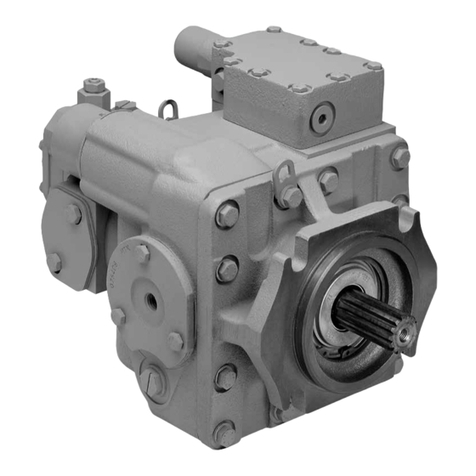
Danfoss
Danfoss Series 20 Service manual
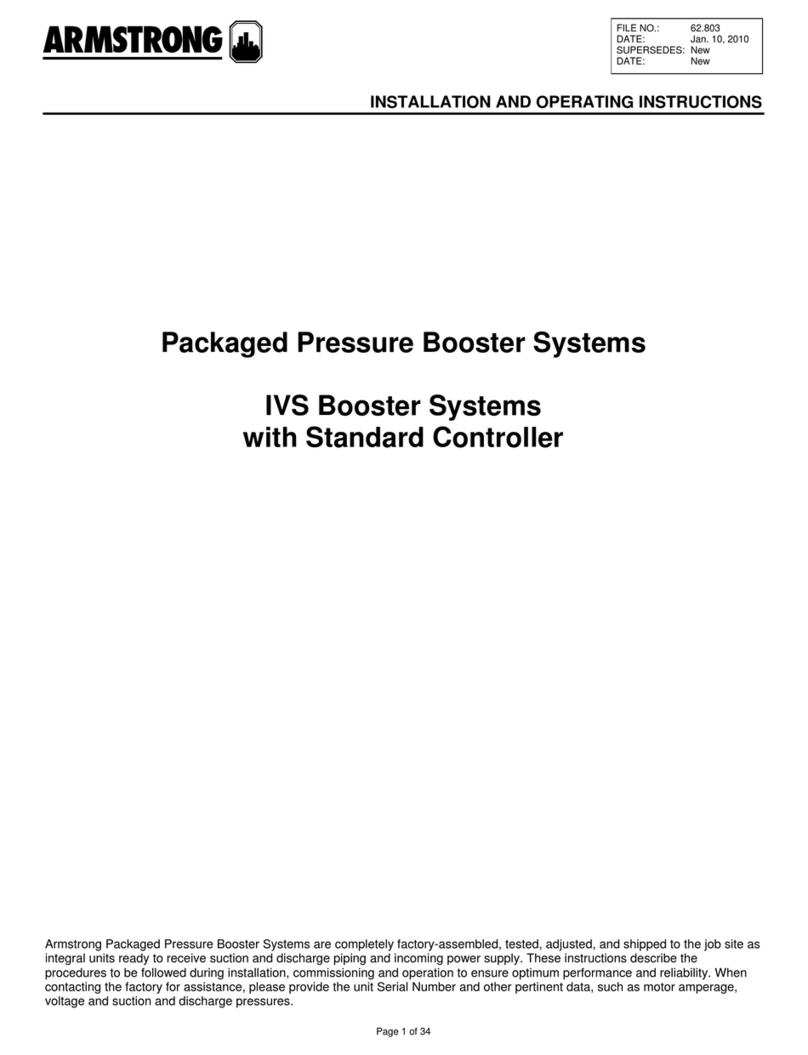
Armstrong
Armstrong IVS series Installation and operating instructions
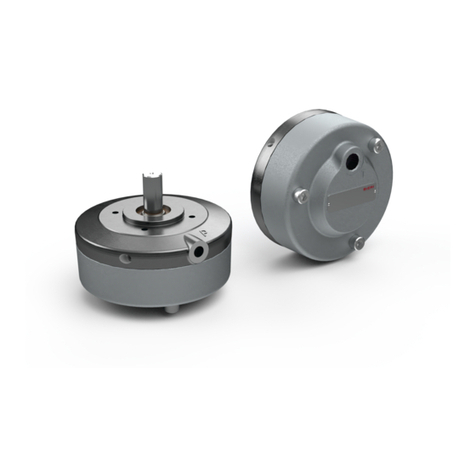
Bieri
Bieri SRK701-ATEX operating instructions

Nocchi
Nocchi SR3 xx/40 Series Use and maintenance manual

BLACKMER
BLACKMER LGLH2A Installation, operation and maintenance instructions

Graco
Graco fire-ball 425 Instructions-parts list
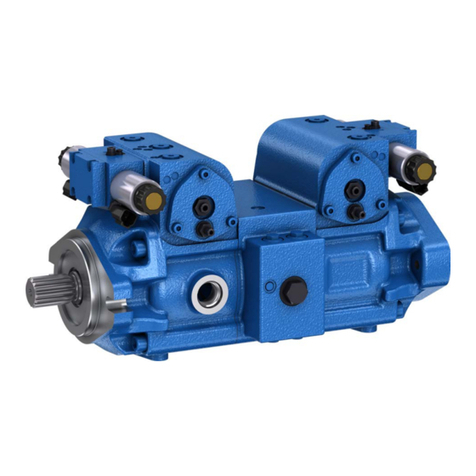
Bosch
Bosch rexroth A21VG 10 Series instruction manual
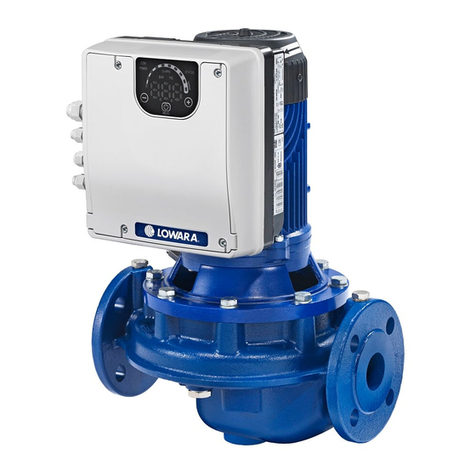
Lowara
Lowara e-LNEEE Installation, operation and maintenance manual
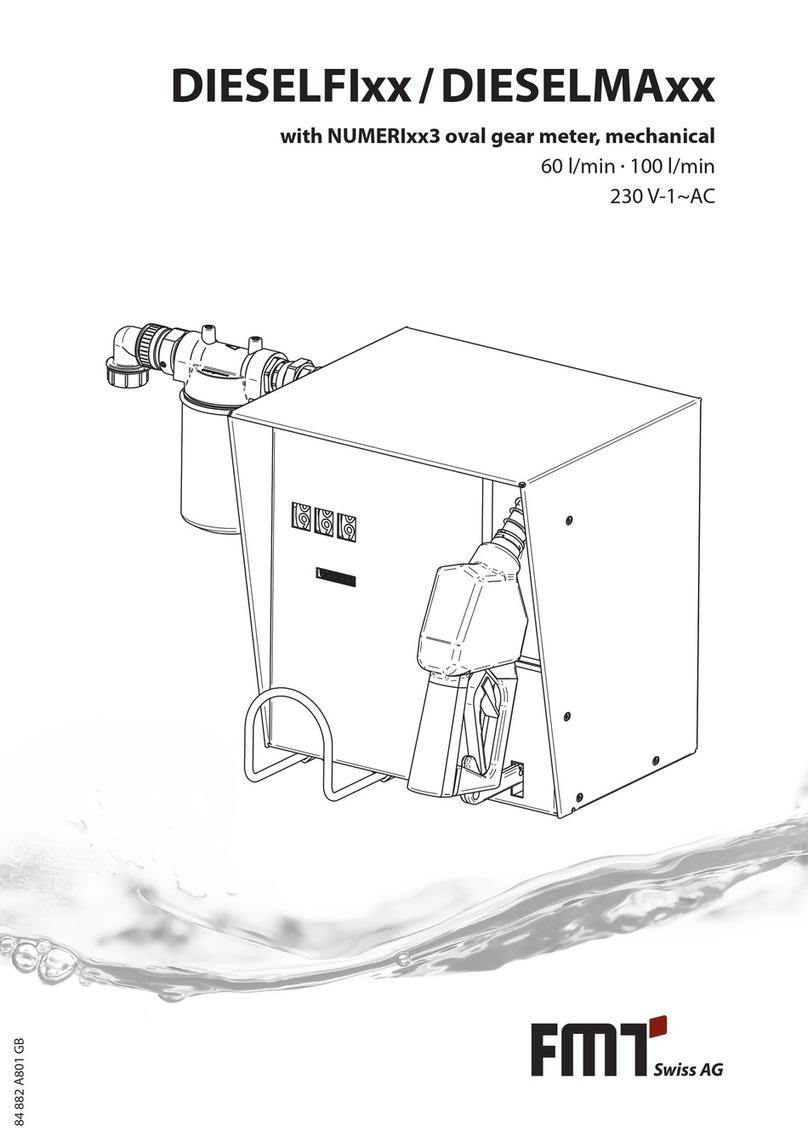
FMT
FMT DIESELFI Series operating instructions

BRINKMANN PUMPS
BRINKMANN PUMPS SXC2824 operating instructions
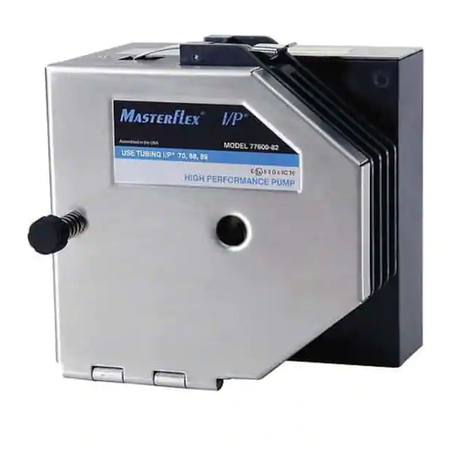
Masterflex
Masterflex I/P 77600-82 operating manual


